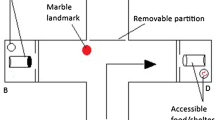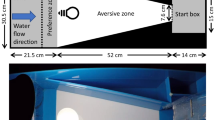Abstract
Many re-introduction programs used for conservation of populations and species threatened with extinction advocate the use of enriched rearing environments to train animals how to behave appropriately in the wild. Curiously, most of the current fish re-stocking programs have paid little attention to lessons previously learned in bird and mammal re-introductions. Many rehabilitation programs that use releases of hatchery fish observe higher mortality in released fish compared to wild, with most mortality arising shortly after release. One explanation for this mortality is based purely on selection processes; many hatchery fish normally selected out of the population thrive in the predator free, food-rich hatcheries. Alternatively, mortalities may be high because hatchery nursery environments fail to shape fish behaviour appropriately. Here, we empirically address the effect of enrichment in the early rearing environment in coastal cod (Gadus morhua). We find asymmetries in aggressive behaviour when fish reared in plain or enriched environments are allowed to interact. Furthermore, cod reared in standard, impoverished, hatchery environments spend less time in shelter, are more active, and show weaker anti-predator responses than fish reared with access to heterogeneous spatial cues. These results suggest that the constant, plain environments of fish farms may generate behavioural deficits that could reasonably be expected to be associated with lower survival in fish released into the wild.


Similar content being viewed by others
References
Aprahamian MV, Smith KM, McGinnity P, McKelvey S, Taylor J (2003) Restocking of salmonids – opportunities and limitations. Fish Res 62:211–227
Basquill SP, Grant JWA (1998) An increase in habitat complexity reduces aggression and monopolization of food by zebra fish (Danio rerio). Can J Zool-Revue 4:770–772
Berejikian BA, Mathews SB, Quinn TP (1996) Effects of hatchery and wild ancestry and rearing environments on the development of agonistic behaviour in steelhead trout (Oncorhynchus mykiss) fry. Can J Fish Aquat Sci 53:204–214
Berejikian BA, Tezak EP, Flagg TA, LaRae AL, Kummerow E, Mahnken CVW (2000) Social dominance, growth and habitat use of age-0 steelhead (Oncorhynchus mykiss) grown in enriched and conventional hatchery rearing environments. Can J Fish Aquat Sci 57:628–636
Berejikian BA Tezak EP, Riley SC, LaRae AL (2001) Competitive ability and social behaviour of juvenile steelhead reared in enriched and conventional hatchery tanks and a stream environment. J Fish Biol 59:1600–161
Berejikian BA, Tezak EP, LaRae AL (2003) Innate and enhanced predator recognition in hatchery-reared chinook salmon. Environ Biol Fish 67:241–251
Borg A, Pihl L, Wennhage H (1997) Habitat choice by juvenile cod (Gadus morhua L) on sandy and soft bottoms with different vegetation types. Helgolander Meeresun 51:197–212
Braithwaite VA, Guilford T (1995) A Loft With A View: Does exposure to natural landmarks during development encourage adult pigeons to use visual landmarks during homing? Anim Behav 49:252–254
Braithwaite VA, Salvanes AG (2005) Environmental variability in the early rearing environment generates behaviourally flexible cod: implications for rehabilitating wild populations. Proc. Roy. Soc. Lond B DOI: 10.1098/rspb.2005.3062
Breden F, Scott M, Michel E (1987) Genetic differentiation for anti-predator behaviour in the Trinidadian guppy, Poecilia reticulata. Anim Behav 35:618–620
Bredy TW, Humpartzoomian RA, Cain DP, Meaney MJ (2003) Partial reversal of the effect of maternal care on cognitive function through environmental enrichment. Neuroscience 118:571–576
Britt A, Welch C, Katz A, et al. (2004) The re-stocking of captive-bred ruffed lemurs (Varecia variegata variegata) into the Betampona Reserve, Madagascar: methodology and recommendations. Biodiver Conserv 13:635–657
Brown C, Laland K (2001) Social learning and life skills training for hatchery fish. J Fish Biol 59:471–493
Carrol SP, Corneli PS (1999) The evolution of behavioural norms of reaction as a problem in ecological genetics: theory, methods and data. In: Foster S Endler JA (eds) Geographic variation in behaviour: Perspectives on evolutionary mechanisms. Oxford University Press, Oxford, pp 52–61
Conover DO, Schultz ET (1995) Phenotypic similarity and the evolutionary significance of counter-gradient variation. Tr Ecol Evol 10:248–252
Deverill JI, Adams CE, Bean CW (1999) Prior residence, aggression and territory acquisition in hatchery-reared and wild brown trout. J Fish Biol 55:868–875
Diggle PD, Liang KY, Zegher SL (1994) The analysis of longitudinal data. Clarendon Press, Oxford
Einum S, Fleming IA (1997) Genetic divergence and interactions in the wild among native, farmed and hybrid Atlantic salmon. J Fish Biol 50:634–651
Fleming IA, Einum S (1997) Experimental tests of genetic divergence of farmed from wild Atlantic salmon due to domestication. ICES J Mar Sci 54:1051–1063
Foster S, Endler JA (1999) Geographic variation in behavior. Perspectives on evolutionary mechanisms. Oxford University Press, Oxford
Giles N, Huntingford FA (1984) Predation risk and inter-population variation in anti-predator behaviour in the three-spined stickleback, Gasterosteus aculeatus L. Anim Behav 32:264–275
Godin JGJ (1978) Behaviour of juvenile pink salmon (Onchorhynchus gorbuscha Walbaum) toward novel prey: influence of ontogeny and experience. Environ Biol Fish 3:261–266
Hamilton LC (1992) Regression with graphics. Duxbury press, Belmont, California
Hilborn R (1998) The economic performance of marine stock enhancement projects. Bull Mar Sci 62:661–674
Hunter SA, Bay MS, Martin ML, Hatfield JS (2002) Behavioural effects of environmental enrichment on harbour seals (Phoca vitulina concolor) and grey seals (Halichoerus grypus). Zoo Biol 21:375–387
Höjesjö J, Johnsson J, Bohlin T (2004) Habitat complexity reduces the growth of aggressive and dominant brown trout (Salmo trutta) relative to subordinates. Behav Ecol Sociobiol 56:286–289
Immelmann K (1975) Ecological significance of imprinting and early learning. Ann Rev Ecol Sys 6:15–37
Imre I, Grant JWA, Keeley ER (2002) The effect of visual isolation on territory size and population density of juvenile rainbow trout (Oncorhynchus mykiss). Can. J Fish Aquat Sci 59:303–309
Johnsson JI, Jonsson E, Bjørnsson BT (1996) Dominance, nutritional state, and growth hormone levels in rainbow trout (Oncorhynchus mykiss). Horm Behav 30:13–21
Kelley JL, Magurran AE (2003) Learned predator recognition and antipredator response in fishes. Fish Fish 4:216–226
Kempermann G, Gast D, Gage FH (2002) Neuroplasticity in old age: sustained five-fold induction of hippocampal neurogenesis by long term environmental enrichment. Ann Neurol 52:135–143
Lindholm JB, Auster PJ, Ruth M, Kaufman L (2001) Modeling the effects of Fishing and implications for the design of marine protected areas: juvenile fish responses to variation in sea floor habitat. Conserv Biol 15:424–437
Machordom A, Garcia-Marin JL, Sanz N, Almodovar A, Pla C (1999) Allozyme diversity in brown trout (Salmo trutta) from central spain: genetic consequences of restocking. Freshwater Biol 41:707–717
Magurran A (1990) The inheritance and development of minnow antipredator behavior. Anim Behav 39:834–842
Metcalfe NB, Valdimarsson SK, Morgan IJ (2003) The relative roles of domestication, rearing environment, prior residence and body size in deciding territorial contests between hatchery and wild juvenile salmon. J Appl Ecol 40:535–544
Nicoll MAC, Jones CG, Norris K (2003) Declining survival rates in a reintroduced population of the Mauritius kestrel: evidence for non-linear density dependence and environmental stochasticity. J Anim Ecol 72:917–926
Nijman V, Heuts BA (2000) Effect of environmental enrichment upon resource holding power in fish in prior residence situations. Behav Proc 49: 77–83
Nordeide JT, Fosså JH, Salvanes AGV, Smedstad O (1994) Testing if year-Class strength of coastal cod (Gadus morhua L) can be determined at the juvenile stage. Aquacult Fish Manage 25(Suppl 1):101–116
Nøstvik F, Pedersen T (1999) Movement patterns and growth of wild cod (Gadus morhua L) and hatchery reared cod released as 1-group. In: Howell BR, Moksness E, Svåsand T (eds) Stock enhancement and sea ranching. Fishing News Books, Blackwell Science Ltd, Oxford. pp.315–333.
O’Connor K, Metcalfe NB, Taylor AC (1999a) The effect of prior residence on behaviour and growth rates in Juvenile Atlantic salmon (Salmo salar). Behav Ecol 11:13–18
O'Connor K, Metcalfe NB, Taylor AC (1999b) Does darkening signal submission in territorial contests between juvenile Atlantic salmon, Salmo salar? Anim Behav 58:1269–1276
O'Connor K, Metcalfe NB, Taylor AC (2000) Familiarity influences body darkening in territorial disputes between juvenile salmon. Anim Behav 59:1095–1101
Odling-Smee L, Braithwaite VA (2003) The influence of habitat stability on landmark use during spatial learning in the three-spined stickleback. Anim Behav 65:701–707
Olla BL, Davis MW, Ryer CH (1994) Behavioural deficits in hatchery-reared fish: potential effects on survival following release. Aquacult Fish Manage 25(Suppl 1):19–34
Olla BL, Davis MW, Ryer CH (1998) Understanding how the hatchery environment represses or promotes the development of behavioural survival skills. Bull Mar Sci 62:531–550
Phillipart JC (1995) Is captive breeding an effective solution for the preservation of endemic species? Biol Conserv 72:281–295
Rabin LA (2003) Maintaining behavioural diversity in captivity for conservation: natural behaviour management. Anim Welfare 12:85–94
Rhodes JS, Quinn TP (1998) Factors affecting the outcome of territorial contests between hatchery and naturally reared coho salmon parr in the laboratory. J Fish Biol 53:1220–1230
Salvanes AGV, Baliño B (1998) Productivity and fitness in a fjord cod population: an ecological and evolutionary approach. Fish Res 37:143–161
Salvanes AGV, Skjæraasen JE, Nilsen T (2004) Sub-populations of coastal cod with different behaviour and life history strategies. Mar Ecol Prog Ser 267:241–251
Seghers BH (1974) Schooling behaviour in the guppy (Poecilia reticulata): an evolutionary response to predation. Evolution 28:486–489
Sundbaum K, Naslund I (1998) Effect of woody debris on the growth and behaviour of brown trout in experimental stream channels. Can J Zool.-Revue 76:56–61
Svåsand T, Kristiansen TS, Pedersen T, Salvanes AGV, Engelsen R, Nævdal G, Nødtvedt M (2000) The biological and economical basis of cod stock enhancement. Fish Fish 1:173–205
Swain DP, Riddel BE, Murray CB (1990) Morphological differences between hatchery and wild populations of coho salmon (Oncorhynchus-kisutch) – environmental versus genetic origin. Can J Fish Aquat Sci 48:1783–1791
ten Cate C, Vos D (1999) Sexual imprinting and evolutionary processes in birds. Adv Study Behav 28:1–31
Tupper M, Boutilier RG (1995a) Size and priority at settlement determine growth and competitive success of newly settled Atlantic cod. Mar Ecol Prog Ser 118:295–300
Tupper M, Boutilier RG (1995b) Effects of habitat on settlement, growth, and post settlement survival of Atlantic cod (Gadus morhua). Can J Fish Aquat Sci 52:1834–1841
Weber ED, Fausch KD (2003) Interactions between hatchery and wild salmonids in streems: differences in biology and evidence for competition. Can J Fish Aquat Sci 60:1018–1036.
Wiltschko W, Wiltschko R, Grüter M, Kowalski U (1987) Pigeon homing: early experience determines what factors are used for navigation. Naturwissenschaften 74:196–198
Winer BJ, Brown DR, Michels KM (1991) Biostatistical analysis. 3rd edn. Prentice-Hall INC, New Jersey
Acknowledgements
This work was funded by the University of Bergen, the Research Council of Norway and The Leverhulme Trust (F/00158/N. AGVS thanks Jim Mallet and the Galton Laboratory, University College of London for providing an excellent working environment while completing the work. We thank D. Aksnes, Nick Colegrave, J. Giske, J. Krause and T. Nilsen for comments on the manuscript, Arild Folkvord, Karin Pittman for discussions, Saga Fjord Sea Farm A/S for providing the fish, and M. Hordnes, F. Midtøy, and J. Skadal for technical assistance. All experiments were carried out with the approval of The Norwegian Veterinary Authorities for Experimental Research; site licence number 18
Author information
Authors and Affiliations
Corresponding author
Additional information
Communicated by J. Krause
Rights and permissions
About this article
Cite this article
Salvanes, A.G.V., Braithwaite, V.A. Exposure to variable spatial information in the early rearing environment generates asymmetries in social interactions in cod (Gadus morhua). Behav Ecol Sociobiol 59, 250–257 (2005). https://doi.org/10.1007/s00265-005-0031-x
Received:
Revised:
Accepted:
Published:
Issue Date:
DOI: https://doi.org/10.1007/s00265-005-0031-x




